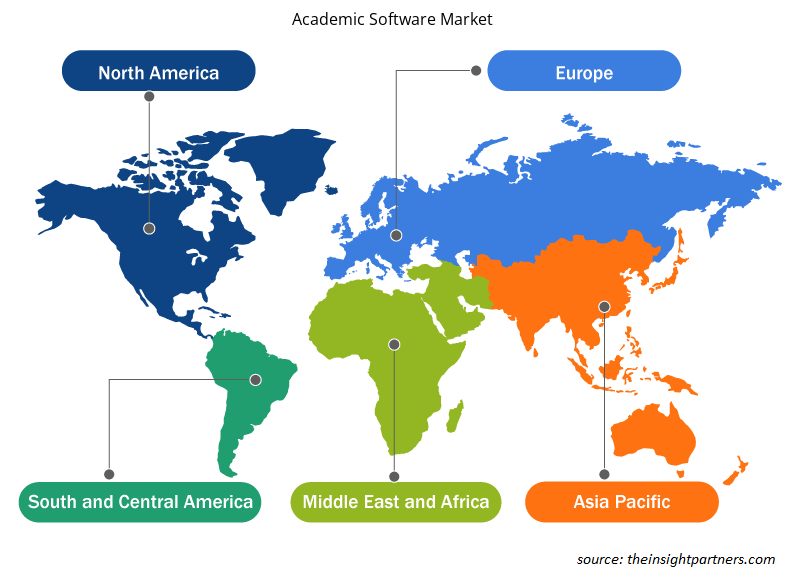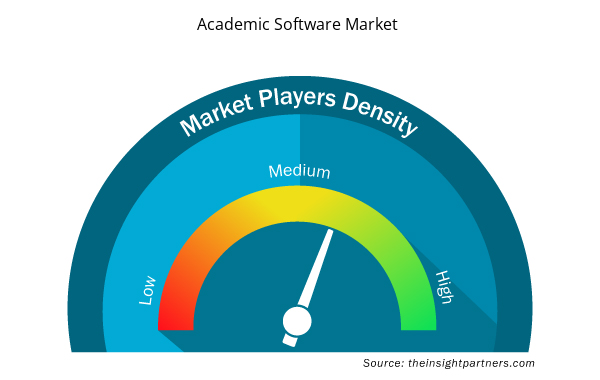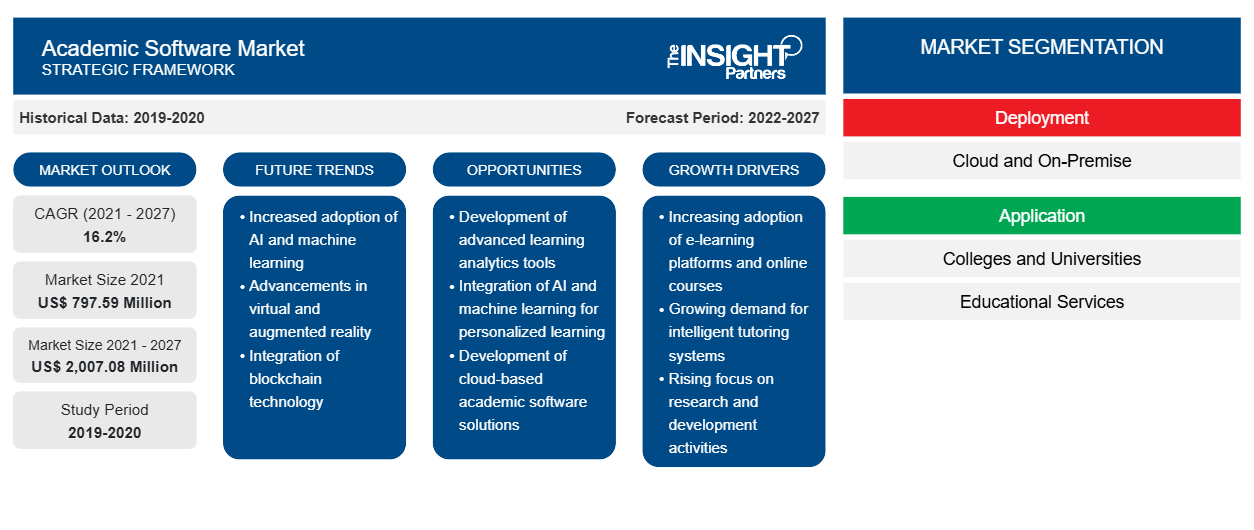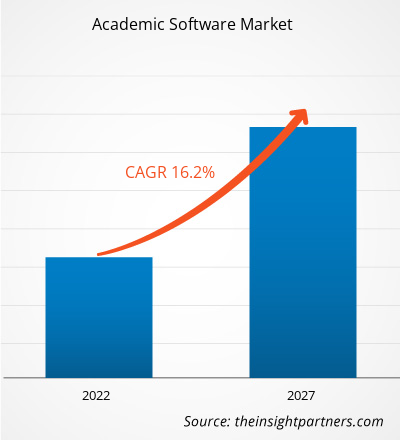学術ソフトウェア市場は、2021年の7億9,759万米ドルから2027年までに20億708万米ドルに成長すると予想されています。学術ソフトウェア市場は、2021年から2027年の予測期間中に16.2%のCAGRで成長すると予想されています。
教育機関全体で eLearning の採用が増えていることが、学術ソフトウェア市場の成長を牽引する主な要因です。eLearning では、コンテンツを読んだり見たりすることで、教育の提供方法が変わります。アニメーション、ポッドキャスト、ビデオなどのさまざまな eLearning コースは、マルチモーダルでリアルな学習環境を作り出します。eLearning の教育コンテンツは、コンピューター、ラップトップ、タブレット、スマートフォンを通じて、学習者にさまざまな没入型学習の機会を提供します。受動的な環境にいる代わりに、学生は学習する必要があるものを簡単かつ迅速に選択できます。これらの利点により、世界中で学術ソフトウェアの需要が高まっています。
COVID-19パンデミックは、世界中の教育分野に深刻な影響を及ぼしています。これにより、世界中のすべての主要経済国でオンライン教育システムの採用も促進され、遠隔地からの講義の配信、学生の管理、その他の運用活動など、さまざまなアプリケーション用のソフトウェアの採用に影響を与えています。したがって、分野全体で技術的に高度なソリューションの採用が増えることは、パンデミック中の学術ソフトウェア市場の成長にプラスの影響を与えると予想されます。
導入に基づいて、学術ソフトウェア市場はクラウドとオンプレミスに分かれています。2019年には、クラウドセグメントが市場で高いシェアを占めました。近年、テクノロジー業界ではクラウドベースのコンピューティングの採用が着実に増加しています。これは、クラウドベースのコンピューティングにより実装時間が簡素化され、導入コストが大幅に削減されるためです。この利点は多くのエンドユーザーを引き付けており、そのため、学術ソフトウェア市場のプレーヤーの大半は、クラウドベースのソフトウェアの需要の高まりに合わせてクラウドベースの製品を提供しています。さらに、先進国のインターネットインフラストラクチャは進化しており、多くの発展途上国で繁栄しており、エンドユーザーは先進国と発展途上国の両方でクラウドベースのソリューションにアクセスできます。
要件に合わせてレポートをカスタマイズする
このレポートの一部、国レベルの分析、Excelデータパックなど、あらゆるレポートを無料でカスタマイズできます。また、スタートアップや大学向けのお得なオファーや割引もご利用いただけます。
- このレポートの主要な市場動向を入手してください。この無料サンプルには、市場動向から見積もりや予測に至るまでのデータ分析が含まれます。
学術ソフトウェア市場の洞察
人工知能などの技術と学術ソフトウェアソリューションの統合
人工知能 (AI) は、人間と同じように、コンピューターに人とコミュニケーションをとり、出来事を理解し、出来事を学習して反応する能力を与えるテクノロジーです。長年にわたり、人工知能はセキュリティや監視、情報技術などの業界全体で膨大なアプリケーションが採用されてきただけでなく、教育分野でもテクノロジーの採用が増加してきました。AI は、採点、財務分析、入学手続きなどの反復的なタスクを自動化するために、学校、大学、および総合大学全体で採用されています。たとえば、自動採点などの高度なコンピューター プログラムを通じて、採点中に教師の行動を学習してモデル化するように AI を調整し、将来的に自動的に成績を割り当てることができます。時間の経過とともに、プログラムは複数の学生の学力を学び、そのパフォーマンスに基づいてカスタマイズされたトレーニング プランを準備します。
展開ベースの市場洞察
導入タイプに基づいて、世界の学術ソフトウェア市場はクラウドとオンプレミスに分かれています。クラウドベースの学術ソフトウェアは、オンプレミスの学術ソフトウェアに比べて需要が高くなっています。クラウドセグメントは、先進国における強力なネットワークインフラストラクチャにより比較的安価であるため、需要の大部分を生み出しています。さらに、クラウドベースの学術ソフトウェアベンダーは、サイバー攻撃のリスクを排除するために、高度なセキュリティパッチの開発に重点を置いています。この要因もエンドユーザーからの大きな需要を生み出し、学術ソフトウェア市場を牽引しています。
アプリケーションベースの市場分析
アプリケーションに基づいて、学術ソフトウェア市場は大学、教育サービス、その他に分類されます。教育機関や大学でオンラインとオフラインの両方のコースを学生に提供するための最新ソリューションの導入が増えていることと、すべてのスタッフと学生が高度なソリューションを利用できるようにするための取り組みが、学術ソフトウェアの導入に影響を与えています。これが、長年にわたる市場の成長を後押ししています。
学術ソフトウェア市場で活動する企業は、学術ソフトウェア市場での地位を維持するために、市場イニシアチブ、買収、製品の発売などの戦略に重点を置いています。学術ソフトウェア市場の主要企業によるいくつかの開発は次のとおりです。
2020 年 12 月、Alma 学生情報システム プラットフォームは、成績表ツールに追加された成績平均点 (GPA) 機能を導入しました。標準ベースの評価 (SBG) は、複数のトピックや標準をカバーするために単一のスコアを使用するのではなく、指導および評価されている特定のスキルに対して学生のフィードバックと進捗状況の測定を一致させることに根ざしています。
2020 年 7 月、ConexED は iOS アプリ 2.2.3 を更新し、よりユーザーフレンドリーなエクスペリエンスを実現しました。このアプリにより、学生、スタッフ、教員はモバイル デバイスで仮想会議やビデオ会議に参加できます。
学術ソフトウェア市場の地域別分析
予測期間を通じて学術ソフトウェア市場に影響を与える地域的な傾向と要因は、Insight Partners のアナリストによって徹底的に説明されています。このセクションでは、北米、ヨーロッパ、アジア太平洋、中東およびアフリカ、南米および中米にわたる学術ソフトウェア市場のセグメントと地理についても説明します。

- 学術ソフトウェア市場の地域別データを入手
学術ソフトウェア市場レポートの範囲
| レポート属性 | 詳細 |
|---|---|
| 2021年の市場規模 | 7億9,759万米ドル |
| 2027年までの市場規模 | 2,007.08百万米ドル |
| 世界のCAGR(2021年~2027年) | 16.2% |
| 履歴データ | 2019-2020 |
| 予測期間 | 2022-2027 |
| 対象セグメント | 展開別
|
| 対象地域と国 | 北米
|
| 市場リーダーと主要企業プロフィール |
|
学術ソフトウェア市場のプレーヤー密度: ビジネスダイナミクスへの影響を理解する
学術ソフトウェア市場は、消費者の嗜好の変化、技術の進歩、製品の利点に対する認識の高まりなどの要因により、エンドユーザーの需要が高まり、急速に成長しています。需要が高まるにつれて、企業は提供内容を拡大し、消費者のニーズを満たすために革新を起こし、新たなトレンドを活用し、市場の成長をさらに促進しています。
市場プレーヤー密度とは、特定の市場または業界内で活動している企業または会社の分布を指します。これは、特定の市場スペースに、その市場規模または総市場価値に対してどれだけの競合相手 (市場プレーヤー) が存在するかを示します。
学術ソフトウェア市場で事業を展開している主要企業は次のとおりです。
- アルマ
- キャンパスカフェソフトウェア
- コネックスED
- エンビジオソリューションズ株式会社
- フルファブリック
免責事項:上記の企業は、特定の順序でランク付けされていません。

- 学術ソフトウェア市場のトップキープレーヤーの概要を入手
学術ソフトウェア市場 – 導入別
- 雲
- オンプレミス
学術ソフトウェア市場 – アプリケーション別
- 大学
- 教育サービス
- その他
学術ソフトウェア市場 – 地域別
北米
- 私たち
- カナダ
- メキシコ
ヨーロッパ
- フランス
- ドイツ
- ロシア
- 英国
- イタリア
- その他のヨーロッパ
アジア太平洋(APAC)
- 中国
- インド
- 日本
- オーストラリア
- 韓国
- その他のアジア太平洋地域
外務省
- サウジアラビア
- アラブ首長国連邦
- 南アフリカ
- MEAの残り
サム
- ブラジル
- アルゼンチン
- 残りのSAM
学術ソフトウェア市場 – 企業プロファイル
- アルマ
- キャンパスカフェソフトウェア
- コネックスED
- エンビジオソリューションズ株式会社
- フルファブリック
- PowerVista Software 社
- クアルトリクスLLC
- トップハットモノクル社
- トゥルーダイアログ
- ワイズハイブ
- 過去2年間の分析、基準年、CAGRによる予測(7年間)
- PEST分析とSWOT分析
- 市場規模価値/数量 - 世界、地域、国
- 業界と競争環境
- Excel データセット


- Non-Emergency Medical Transportation Market
- Adaptive Traffic Control System Market
- Hydrolyzed Collagen Market
- Sodium Bicarbonate Market
- Hair Extensions Market
- Electronic Signature Software Market
- Blood Collection Devices Market
- Water Pipeline Leak Detection System Market
- Precast Concrete Market
- Bathroom Vanities Market

Report Coverage
Revenue forecast, Company Analysis, Industry landscape, Growth factors, and Trends

Segment Covered
This text is related
to segments covered.

Regional Scope
North America, Europe, Asia Pacific, Middle East & Africa, South & Central America

Country Scope
This text is related
to country scope.
よくある質問
Increase in adoption of modern technologies and rapid shift from traditional teaching methodologies to modern teaching techniques are influencing the adoption of academic software solutions across colleges and universities across the globe. Additionally, software packages taken by universities and colleges for a large number of users are also cost efficient for both the institutions and the students. In the private sector, for instance, many software packages that a student wants are very expensive. This is why VIVES University of Applied Sciences has developed a partnership to deliver academic solutions with Signpost. Bulk transaction or software license transactions would substantially lower the cost of all their students' required application. A standard software package is compiled by VIVES on Signpost's Academic Software platform, which consists of hundreds of software titles that must be purchased by any VIVES student as a compulsory learning material, regardless of the education or training process. The same can be installed and used on personal laptops and desktops of students. Thus, increasing initiatives by colleges and universities to install bulk academic solutions for students are contributing to the academic software market growth across the globe.
The software industry is growing at a fast pace in the region as it attracts various technological developments. The US federal government spends ~US$ 79 billion every year on the development of primary and secondary education programs. In addition, the trend of privatizing schools in the US is prevailing which is another aspect that would help in boosting the scope of integrating advanced software in schools. In the 21st century, the education sector is experiencing numerous efforts to privatize educational services which were provided by public agencies & school systems. Privatization is expected to transform the method of running schools and will open up opportunities for integrating new software and technologies to manage operations in educational institutes efficiently.
Artificial intelligence (AI) is a technology that gives computers the ability, in the same way as humans, to communicate with people, understand events, and learn and react to events. Over the years, artificial intelligence not only had huge applications across industries—such as security and surveillance and information technology—but it had also experienced a rise in adoption of the technologies in the education sector. AI is being adopted across schools, colleges, and universities for automating repetitive tasks, such as grading, financial analysis, and admission processes. For example, AI can be calibrated to learn and model teacher actions while grading, through advanced computer programs—such as Automated Grading—for automatic grade assignment in the future. Over time, the program would learn the academic skills of multiple students and, based on their performances, prepare customized training plans.
Trends and growth analysis reports related to Technology, Media and Telecommunications : READ MORE..
The List of Companies - Academic Software Market
- Alma
- CAMPUS CAFÉ SOFTWARE
- ConexED
- Envisio Solutions Inc.
- FULL FABRIC
- PowerVista Software, Inc.
- Qualtrics LLC
- Tophatmonocle Corp
- TrueDialog
- WizeHive
The Insight Partners performs research in 4 major stages: Data Collection & Secondary Research, Primary Research, Data Analysis and Data Triangulation & Final Review.
- Data Collection and Secondary Research:
As a market research and consulting firm operating from a decade, we have published and advised several client across the globe. First step for any study will start with an assessment of currently available data and insights from existing reports. Further, historical and current market information is collected from Investor Presentations, Annual Reports, SEC Filings, etc., and other information related to company’s performance and market positioning are gathered from Paid Databases (Factiva, Hoovers, and Reuters) and various other publications available in public domain.
Several associations trade associates, technical forums, institutes, societies and organization are accessed to gain technical as well as market related insights through their publications such as research papers, blogs and press releases related to the studies are referred to get cues about the market. Further, white papers, journals, magazines, and other news articles published in last 3 years are scrutinized and analyzed to understand the current market trends.
- Primary Research:
The primarily interview analysis comprise of data obtained from industry participants interview and answers to survey questions gathered by in-house primary team.
For primary research, interviews are conducted with industry experts/CEOs/Marketing Managers/VPs/Subject Matter Experts from both demand and supply side to get a 360-degree view of the market. The primary team conducts several interviews based on the complexity of the markets to understand the various market trends and dynamics which makes research more credible and precise.
A typical research interview fulfils the following functions:
- Provides first-hand information on the market size, market trends, growth trends, competitive landscape, and outlook
- Validates and strengthens in-house secondary research findings
- Develops the analysis team’s expertise and market understanding
Primary research involves email interactions and telephone interviews for each market, category, segment, and sub-segment across geographies. The participants who typically take part in such a process include, but are not limited to:
- Industry participants: VPs, business development managers, market intelligence managers and national sales managers
- Outside experts: Valuation experts, research analysts and key opinion leaders specializing in the electronics and semiconductor industry.
Below is the breakup of our primary respondents by company, designation, and region:

Once we receive the confirmation from primary research sources or primary respondents, we finalize the base year market estimation and forecast the data as per the macroeconomic and microeconomic factors assessed during data collection.
- Data Analysis:
Once data is validated through both secondary as well as primary respondents, we finalize the market estimations by hypothesis formulation and factor analysis at regional and country level.
- Macro-Economic Factor Analysis:
We analyse macroeconomic indicators such the gross domestic product (GDP), increase in the demand for goods and services across industries, technological advancement, regional economic growth, governmental policies, the influence of COVID-19, PEST analysis, and other aspects. This analysis aids in setting benchmarks for various nations/regions and approximating market splits. Additionally, the general trend of the aforementioned components aid in determining the market's development possibilities.
- Country Level Data:
Various factors that are especially aligned to the country are taken into account to determine the market size for a certain area and country, including the presence of vendors, such as headquarters and offices, the country's GDP, demand patterns, and industry growth. To comprehend the market dynamics for the nation, a number of growth variables, inhibitors, application areas, and current market trends are researched. The aforementioned elements aid in determining the country's overall market's growth potential.
- Company Profile:
The “Table of Contents” is formulated by listing and analyzing more than 25 - 30 companies operating in the market ecosystem across geographies. However, we profile only 10 companies as a standard practice in our syndicate reports. These 10 companies comprise leading, emerging, and regional players. Nonetheless, our analysis is not restricted to the 10 listed companies, we also analyze other companies present in the market to develop a holistic view and understand the prevailing trends. The “Company Profiles” section in the report covers key facts, business description, products & services, financial information, SWOT analysis, and key developments. The financial information presented is extracted from the annual reports and official documents of the publicly listed companies. Upon collecting the information for the sections of respective companies, we verify them via various primary sources and then compile the data in respective company profiles. The company level information helps us in deriving the base number as well as in forecasting the market size.
- Developing Base Number:
Aggregation of sales statistics (2020-2022) and macro-economic factor, and other secondary and primary research insights are utilized to arrive at base number and related market shares for 2022. The data gaps are identified in this step and relevant market data is analyzed, collected from paid primary interviews or databases. On finalizing the base year market size, forecasts are developed on the basis of macro-economic, industry and market growth factors and company level analysis.
- Data Triangulation and Final Review:
The market findings and base year market size calculations are validated from supply as well as demand side. Demand side validations are based on macro-economic factor analysis and benchmarks for respective regions and countries. In case of supply side validations, revenues of major companies are estimated (in case not available) based on industry benchmark, approximate number of employees, product portfolio, and primary interviews revenues are gathered. Further revenue from target product/service segment is assessed to avoid overshooting of market statistics. In case of heavy deviations between supply and demand side values, all thes steps are repeated to achieve synchronization.
We follow an iterative model, wherein we share our research findings with Subject Matter Experts (SME’s) and Key Opinion Leaders (KOLs) until consensus view of the market is not formulated – this model negates any drastic deviation in the opinions of experts. Only validated and universally acceptable research findings are quoted in our reports.
We have important check points that we use to validate our research findings – which we call – data triangulation, where we validate the information, we generate from secondary sources with primary interviews and then we re-validate with our internal data bases and Subject matter experts. This comprehensive model enables us to deliver high quality, reliable data in shortest possible time.


 このレポートの無料サンプルを入手する
このレポートの無料サンプルを入手する